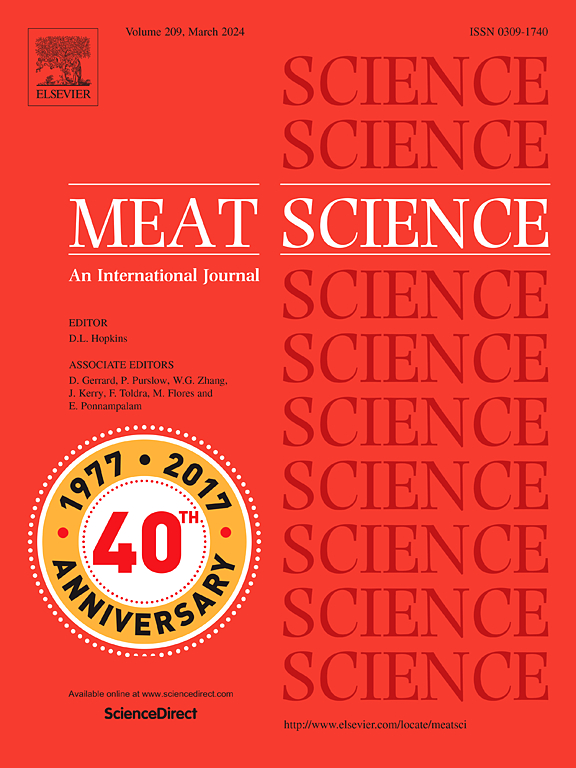Heat transfer enhancement mediated by moisture diffusion improves the volatile profiles of meat stir-fried with high-temperature short-time
IF 7.1
1区 农林科学
Q1 Agricultural and Biological Sciences
引用次数: 0
Abstract
The effect of the heating intensity on the volatile profiles of stir-fried pork slices was explored from the angle of moisture diffusion, which alters the thermal reaction rate. Infrared thermography was used to visually monitor the surface temperature difference between the medium and meat slices to aid in interpreting moisture diffusion behavior. Lower water activity and specific heat capacity mediated by moisture diffusion enriched volatile traits. The difference in moisture diffusion between the low-level fire (LF) group and high-level fire (HF) groups occurred mainly after 1 min of stir-frying. At this stage, 3-methylbutanal, 4-methylthiazole, dihydro-2-methyl-3(2H)-furanone, methylpyrazine, etc. were examined in the HF group, indicating the occurrence of the Maillard reaction, Strecker degradation, and lipid-Maillard interactions, which was supported by the results of free amino acids (FAAs) and Fourier transform infrared spectroscopy (FTIR). Additionally, short-term stir-frying with HF (< 1 min) could obtain the volatile characteristics produced by long-term stir-frying with LF (> 1 min), which might be due to shell formation on the surface of the HF-treated samples in the early stage, accompanied by thermal reactions to produce volatile compounds. This work provides a scientific basis for traditional cooking thought that stir-frying with HF is more fragrant and offers support for the transformation of traditional dishes from kitchens to factories.
水分扩散介导的强化传热改善了高温短时间炒肉的挥发特性
从水分扩散的角度探讨了加热强度对炒猪肉片挥发性特征的影响,从而改变了热反应速率。红外热像仪用于直观地监测介质和肉片之间的表面温差,以帮助解释水分扩散行为。水分扩散介导的较低的水分活度和比热容使挥发性性状丰富。低火(LF)组和高火(HF)组的水分扩散差异主要发生在炒1 min后。本阶段在HF基团中检测了3-甲基丁醛、4-甲基噻唑、二氢-2-甲基-3(2H)-呋喃酮、甲基吡嗪等,表明发生了美拉德反应、streker降解和脂质-美拉德相互作用,并得到了游离氨基酸(FAAs)和傅里叶变换红外光谱(FTIR)结果的支持。另外,用HF (<;1 min)可以得到LF (>;1分钟),这可能是由于在hf处理样品的早期表面形成壳,伴随着热反应产生挥发性化合物。这项工作为“HF炒香”的传统烹饪思想提供了科学依据,为传统菜肴从厨房到工厂的转型提供了支持。
本文章由计算机程序翻译,如有差异,请以英文原文为准。
求助全文
约1分钟内获得全文
求助全文
来源期刊

Meat Science
工程技术-食品科技
CiteScore
12.60
自引率
9.90%
发文量
282
审稿时长
60 days
期刊介绍:
The aim of Meat Science is to serve as a suitable platform for the dissemination of interdisciplinary and international knowledge on all factors influencing the properties of meat. While the journal primarily focuses on the flesh of mammals, contributions related to poultry will be considered if they enhance the overall understanding of the relationship between muscle nature and meat quality post mortem. Additionally, papers on large birds (e.g., emus, ostriches) as well as wild-captured mammals and crocodiles will be welcomed.
 求助内容:
求助内容: 应助结果提醒方式:
应助结果提醒方式:


